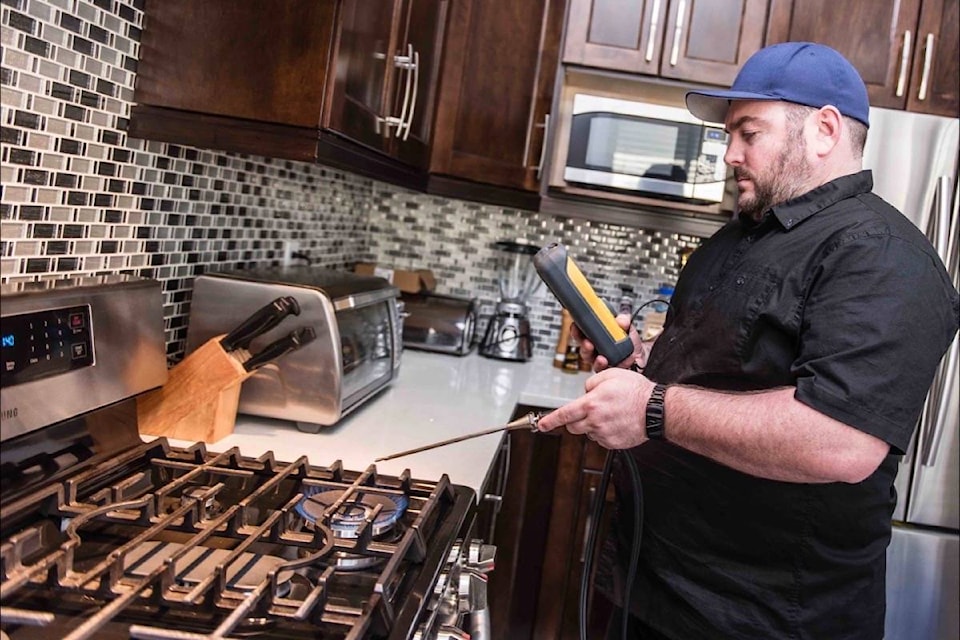Carbon monoxide—which can be neither seen nor smelled—has been called the “silent killer”. In March 2017 it claimed the lives of a family of four living at Venables Valley in what Ashcroft Volunteer Fire Department (AVFD) chief Josh White calls a very tragic accident.
“I hope I never have to attend a tragedy like that again,” he says. “And it could have been prevented.”
An investigation by Technical Safety BC showed that an incorrectly-installed tankless, on-demand water heater in the living area of the home was venting carbon monoxide indoors. The installation of the water heater was unpermitted, unlicensed, and unsafe, but the family—which included children aged seven and 10—could have been warned if they had had a carbon monoxide detector installed.
White, who has been on the AVFD for more than 20 years, says it was the first carbon monoxide fatality he had attended. “I’ve attended false reading calls, and one where a carbon monoxide detector found a leak. It’s very rare that we have these incidents, but they do happen.
“Gas furnaces, or wood fireplaces and stoves, can all create carbon monoxide. People in apartments say ‘I don’t need a detector, I have electric heat,’ so I ask what’s heating their water? A boiler system. And what if you have vehicles running in a garage or carport? Carbon monoxide is out there in anything that doesn’t burn clean; it’s a by-product of incomplete combustion.”
White cites a case involving a brand new apartment complex in Calgary where snow fell and blocked the vent for the building’s boiler system, causing a build-up of carbon monoxide that was caught by detectors. And he says that new furnaces and boiler systems are being put in which vent to the back yard rather than through the roof.
“The vent is a PVC pipe that’s about five feet off the ground. It could be blocked by a child, who thinks it’s a fun place to hide stuff.”
Technical Safety BC notes that most carbon monoxide incidents take place in residences, and involve furnaces, boilers, or water heaters.
“There is a temptation for homeowners to save on costs by either installing home equipment and appliances themselves, or using someone who is not licensed,” says Janice Lee, director of oversight at Technical Services BC. “But they need to realize that the risks really do outweigh the cost. Homeowners need to be aware of carbon monoxide risks around the home and use licensed contractors with the appropriate permits when maintaining or installing equipment.”
While carbon monoxide can kill, breathing low levels of it over a long period of time can also cause severe heart problems and brain damage. “People here got headaches from the smoke from last year’s wildfires,” says White. “It was carbon monoxide in the smoke causing those headaches. It wasn’t a lethal amount, but it was out there.”
White advises having at least one carbon monoxide detector on each level of your residence, with one in close proximity to the bedrooms to wake you up if you’re asleep. “People ask if I should put it high or low, but carbon monoxide is close in weight to the air we breathe, and the air in a home is always moving anyway, so it will hit the detector. Just don’t have curtains or anything else that could act as a potential filter blocking it.
“Hallways are best, as they’re usually kept clear.”
As for cost, White says you don’t need detectors that cost a lot. “I bought detectors for $30 each. They do the job fine. They have a 10-year life, so that’s $3 a year to protect your family, so arguing cost on this one doesn’t work. I’ll spend more than $3 at Tim Hortons in one sitting.”
He adds that the detectors do not need wiring; they simply plug into an existing wall outlet. They should be cleaned lightly each month with a soft brush, and tested weekly or monthly, which involves just pushing a button.
White cautions that some older detectors might only have a five-year lifespan. “Look for an expiry date on it. If there’s no expiry date, and you can’t remember when it was installed, replace it. And don’t forget about the 10-year life on smoke detectors. People forget that they expire.”
Tips to prevent carbon monoxide poisoning include regular inspections of gas appliances; keeping the area around your furnace clear for proper air circulation; keeping all ducts, vents, and screens free from obstructions; never operating portable fuel-burning devices, or gas-powered generators, lawn equipment, or engines, indoors or in closed spaces; and not leaving a vehicle engine running inside an enclosed garage or space.
Some warning signs of carbon monoxide gas at home include loose, disconnected, rusty, or water-streaked chimney vents; soot build-up or discolouration on fireplaces; discolouration of fuel-burning appliances or heating system warm air vents; window condensation; or sick or dying pets or plants.
If you suspect carbon monoxide exposure, get outdoors immediately. Once safely outdoors, call 9-1-1, and seek immediate medical attention, as carbon monoxide poisoning can be fatal if left untreated. Mild symptoms could be mistaken for the flu or fever, while strong symptoms include breathlessness, confusion, or hallucinations. Severe symptoms are life-threatening, and can include collapse, convulsions, or unconsciousness.
Above all, says White, install and maintain carbon monoxide detectors.
“When it comes to my children and my family, that $30 is money well spent.”
To learn more, visit www.technicalsafetybc.ca.
